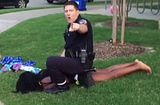Pool-Party Cop's Attorney Denies Race Played a Factor: Why We're Not Buying It

by Dyaundra Stroman
The lawyer for McKinney, Texas officer, Eric Casebolt held a press conference on Wednesday to explain her client's actions and to issue an apology "to all who were offended." Jane Bishkin, Casebolt's attorney, stated her client responded to two suicide calls prior to arriving at the Craig Ranch pool-party disturbance. The officer was recorded slamming 15-year-old Dejerria Becton to the ground before drawing his weapon on the party-going teenagers. Bishkin attributed her client's behavior to the "emotional stress" he was under having just photographed a scene in which a man shot himself in front of his family. She went on to dismiss the accusation that race played a factor in the way Casebolt conducted himself during the Craig Ranch ordeal. She claims he was only attempting to investigate a "violent assault." She further maintained, "he was not targeting minorities."
While it's understandable that the events which preceded Casebolt's arrival to the pool-party were psychologically taxing, it does not give him license to unleash his frustrations on a group of children. The brutal conduct Casebolt demonstrated, represent the reason relations between the police and Black communities remain strained. Frequent encounters of blatant racism from these civil servants sow seeds of distrust, discord, and fear of law enforcement among African Americans. We can't ignore the harmful impact of his actions because he was under pressure from his job. Sorry, but even in light of this new information, to quote the Mckinney Chief of Police Greg Conley, Casebolt's tactics were still "indefensible."
Casebolt's excessive force was unwarranted. As seen in Brooks' seven-minute video, the teens were already vacating the pool area. Thus, they were committing no crime. The McKinney Police Department released a statement detailing the fiasco via their facebook page: "The initial call came in as a disturbance involving multiple juveniles at the location, who do not live in the area or have permission to be there, refusing to leave." How did Casebolt determine the teens he addressed were not residents of the community? How did he so quickly ascertain they did not have permission to be there? If he was not "targeting" black youths, then why was he chasing them down exclusively while, as Brooks described to Buzzfeed News, the white kids were "invisible" to him? The underlying fact is that Casebolt reconciled their guilt based on the color of their skin. These kids were profiled and subsequently criminalized based entirely on their race. He had erroneously concluded that there was no way any of the black kids were residents of the Craig Ranch community or invited guests. His prejudiced mentality gathered that they didn't belong in the affluent suburb.
Casebolt had come under fire in the past for similar actions, as federal court documents show a federal lawsuit was filed against him in 2008 for racial profiling and excessive force. While the suit was dismissed in 2009, that claim compounded by the behavior he exhibited in the video, are indicators that race plays a huge role his way of policing.
These children were grossly violated by Casebolt -- who acted with a complete disregard for their well being. After having your inalienable human rights infringed upon at such an impressionable age, what image of law enforcement will become forever ingrained in your mind? What perspective will you then have on who the police are really there to protect and serve? Because after having their adolescence stained with this act of injustice, surely these kids are not expected to believe it's them. Are we to excuse his deplorable actions and overlook his racially charged inclinations simply because he was having a bad day at work? If we are to believe that Casebolt operated with color-blind egalitarianism, we'll be doing so at the expense of our children's self worth.
The Craig Ranch ordeal is yet another event that leaves us wondering when will the dehumanization of black people in America end? Until we collectively come together as a society to bring meaningful change to race relations in this country, it will only persist. Until we acknowledge the underpinnings of racism in American culture, we cannot move forward. Until we recognize the harm we cause the entire nation by denying equality to minorities, incidents like the one in McKinney will only continue. For these reasons, we must not pretend to be oblivious to Eric Casebolt's bigoted motivations in that video. Doing so, sets a dangerous precedent that threatens our fight for black liberation.
Photo: YouTube

No comments: